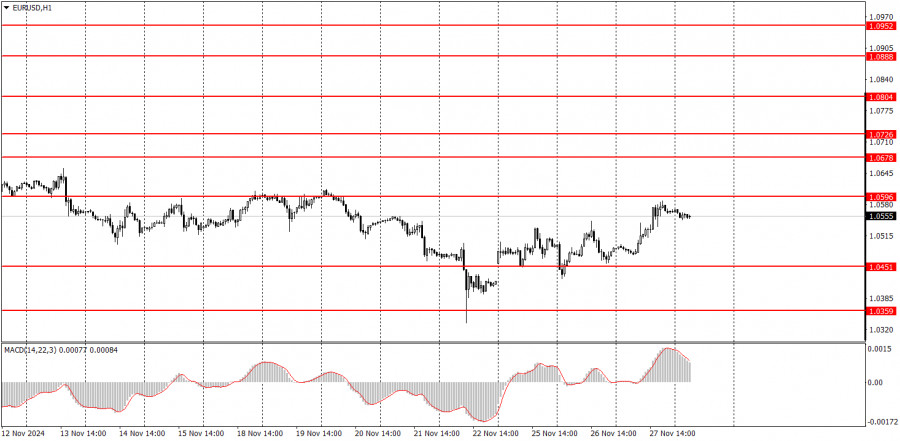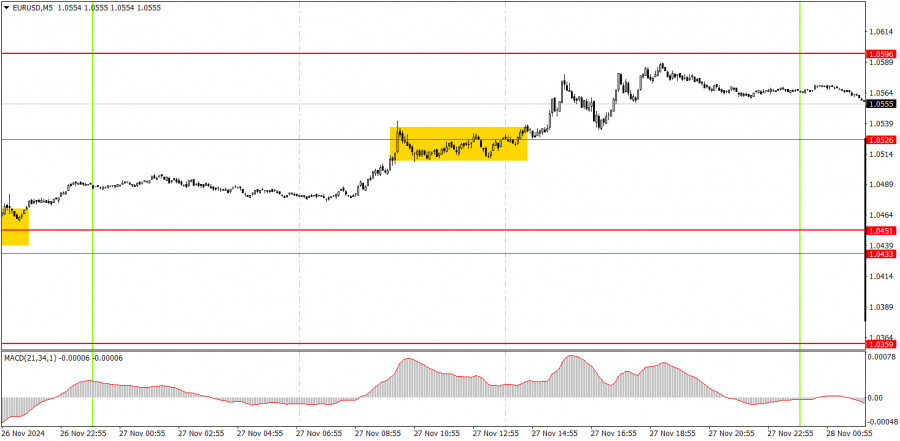
1H Chart of EUR/USD:

On Wednesday, the EUR/USD currency pair continued its correction despite lacking strong justification for the move. The U.S. released five significant reports yesterday, four of which had no impact as their values matched forecasts. The only notable report was on durable goods orders, which came in 0.3% below expectations. Thus, the dollar's decline was somewhat justified. However, the issue lies in the fact that the dollar began weakening in the morning, even though the U.S. statistics were released later in the afternoon. This suggests the market was inclined to sell the dollar from the start of the day.
As we've noted before, the correction is logical, but it could end at any moment. Its scale is uncertain and depends largely on the macroeconomic and fundamental background in the coming days.
5M Chart of EUR/USD:

On the 5-minute timeframe, only one clear trading signal appeared on Wednesday. During the European session, the price broke through the 1.0526 level and almost reached the next target level. Unfortunately, it didn't quite touch the 1.0596 level, but novice traders still had ample time to close long positions with a profit.
How to Trade on Thursday:On the hourly timeframe, the EUR/USD pair continues its attempt to correct. However, the upward move is likely to remain modest. A brief upward retracement is possible in the coming days, as the price has reached the lower boundary of the sideways channel on the weekly timeframe—a level we've mentioned multiple times. However, this does not guarantee a strong or prolonged rise.
On Thursday, we anticipate continued growth in prices, though the macroeconomic backdrop is expected to be weak, which may result in a range-bound market.
On the 5-minute timeframe, monitor the following levels: 1.0269-1.0277, 1.0334-1.0359, 1.0433-1.0451, 1.0526, 1.0596, 1.0678, 1.0726-1.0733, 1.0797-1.0804, 1.0845-1.0851, 1.0888-1.0896.
There are no significant events scheduled in the U.S. for Thursday, but Germany will release an inflation report. This report is mainly important for its implications on the upcoming eurozone inflation data. In both cases, higher inflation readings are supportive of the euro.
Key Trading Rules:Signal strength is determined by the time it takes to form (a bounce or breakthrough of a level). The less time it takes, the stronger the signal.If two or more trades from a specific level result in false signals, subsequent signals from that level should be ignored.In a range-bound market, currency pairs can generate numerous false signals or none at all. If range-bound conditions appear, it is better to stop trading.Trades should only be opened during the European session and the first half of the U.S. session. All trades should be closed manually afterward.On the hourly timeframe, use MACD signals only when volatility is high and the trend is confirmed by a trendline or channel.If two levels are very close to each other (5-20 points), treat them as a support or resistance area.Upon moving 15 points in the expected direction, set a Stop Loss to breakeven.What the Charts Show:Support and resistance price levels: These are targets for opening buy or sell trades. Take Profit levels can also be placed near these areas.Red lines: Channels or trendlines indicating the current trend direction, guiding preferred trading directions.MACD Indicator (14,22,3): The histogram and signal line serve as supplementary indicators and sources of signals.Significant speeches and reports: Always listed in the economic calendar, these can heavily influence currency pair movements. Trade cautiously or exit positions during such events to avoid sharp price reversals.Advice for Beginners:Not every trade can be profitable. A well-developed strategy and proper money management are the keys to long-term success in forex trading.